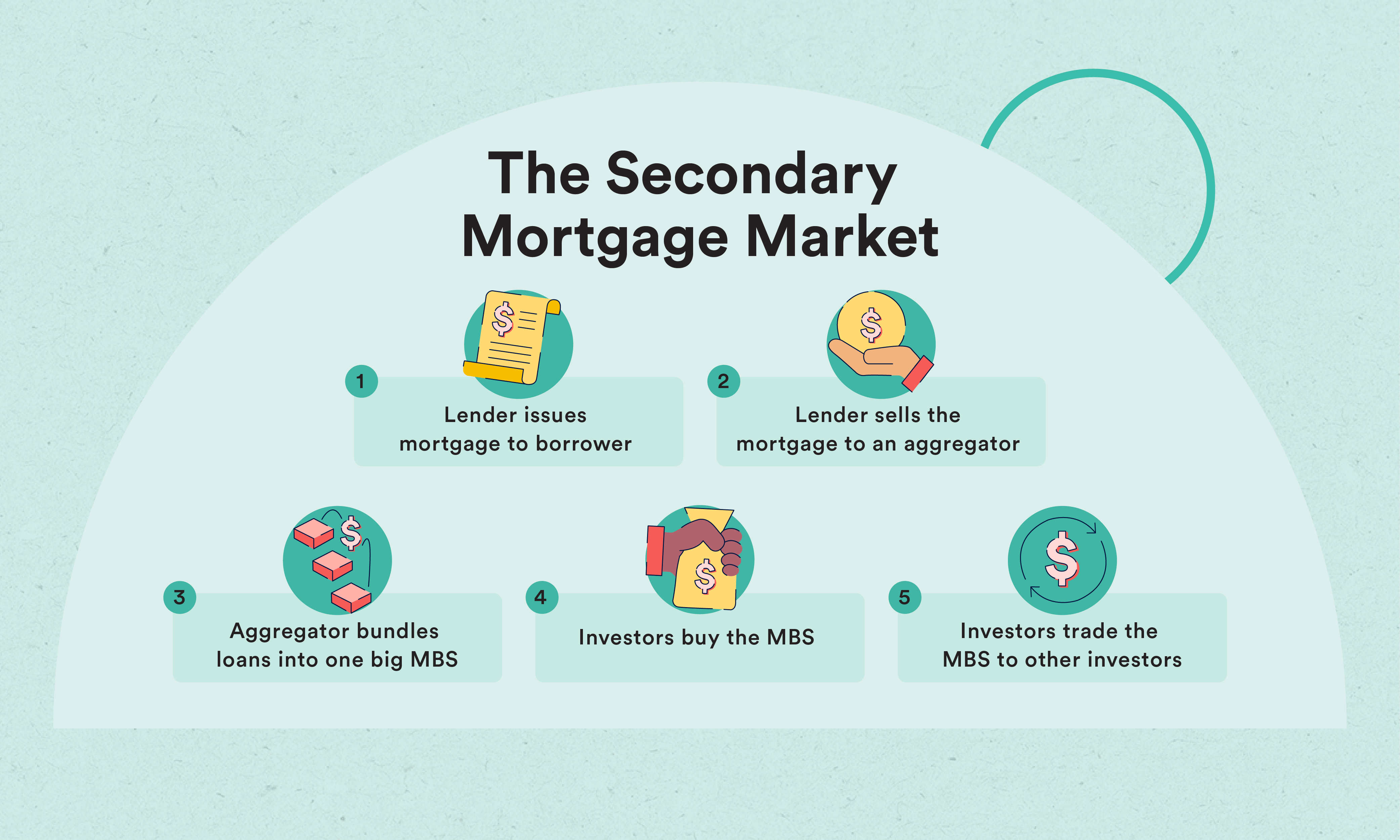Secondary mortgage market: What it is and how it works

The Bankrate promise
At Bankrate we strive to help you make smarter financial decisions. While we adhere to strict , this post may contain references to products from our partners. Here's an explanation for .
Key takeaways
- The secondary mortgage market is a financial marketplace, where investors buy and sell bundled packages consisting of many individual loans — called mortgage-backed securities.
- While you the homebuyer aren’t directly involved in it, the secondary market impacts your ability to get a mortgage and how much that loan costs.
When you get a mortgage, you might expect to repay your lender over the next 15 or 30 years. However, the truth is that many banks and other lenders originate mortgages only to sell them to other investors.
The secondary mortgage market is massive, and many homebuyers aren’t aware of it or how it works. Despite this, the secondary market plays a big role in your ability to get a mortgage and how much that loan costs.
What is the secondary mortgage market?
The secondary mortgage market is a marketplace where investors buy and sell mortgages that have been securitized — that is, packaged into bundles of many individual loans. Mortgage lenders originate loans and then place them for sale on the secondary market. Investors who purchase those loans receive the right to collect the money owed.
Just like any market for securities, the value of mortgages on the secondary market depends on their risk and potential return. Higher-risk loans must offer higher returns, which is one of the reasons that people with lower credit scores pay higher interest rates.
Primary vs. secondary mortgage market
The primary mortgage market is where borrowers get mortgages from lenders. For example, if you go to a local credit union and a couple of banks to get a quote for a mortgage, you’re participating in the primary mortgage market.
The secondary mortgage market doesn’t involve borrowers at all. Instead, it’s where lenders sell loans they’ve originated to investors.
How the secondary mortgage market works
After originating a loan, a lender often sells it in the secondary mortgage market, though the lender may retain the servicing rights. Many lenders sell loans to the government-sponsored enterprises (GSEs) Fannie Mae and Freddie Mac or to other aggregators. These aggregators can repackage the loans as mortgage-backed securities (MBS), or hold them on their own books and collect the interest from borrowers.
To be sold to the GSEs, the loan must be “conforming” — that is, it must meet certain standards set by the Federal Housing Finance Agency (FHFA), which oversees Fannie and Freddie. These factors include:
- A maximum loan amount of $766,550 (for 2024) in most markets, though it is higher (up to $1,149,825) in some expensive areas
- The down payment relative to the loan’s size, typically at least 3 percent
- The borrower’s credit score, usually at least 620 to 650
- The borrower’s debt-to-income (DTI) ratio, which should ideally be 36 percent or less
The demand for conforming loans helps push down the mortgage rates for borrowers who can meet the standards. Note that jumbo loans, which are larger in loan size, are not considered conforming loans.
1. A borrower takes out a loan
A homebuyer borrows money from a lender by taking out a mortgage (a conforming loan). The homebuyer gets cash to purchase the home, while the lender holds the buyer’s mortgage and a promise to be paid later at a specified interest rate.
2. The lender sells the loan to an aggregator
The lender sells the loan to a mortgage aggregator — often Fannie Mae or Freddie Mac, who buy two-thirds of the mortgages in the U.S. The lender gets cash for selling the mortgage note, allowing it to use the capital to write another loan. The lender may retain the right to service the mortgage, a service for which it receives a fee.
The lender foregoes any mortgage repayments of principal or interest — because the aggregator now owns the loan after paying cash for it.
3. The aggregator bundles the loans into mortgage-backed securities
The aggregator repeats the process of buying conforming loans, amassing hundreds or thousands of mortgages across the U.S. Then it packages, or “securitizes,” these loans into mortgage-backed securities (MBS). For example, it might combine 1,000 mortgages into one series of MBS. Because the MBS has many mortgages, it’s less risky than buying a single mortgage — similar to a mutual fund that invests in many companies.
Aggregators can structure MBS into many different types of investment products and then sell “shares” in them. They may create a range of bonds that are very safe to a little risky, with lower payouts for the safer bonds and higher payouts for riskier notes. They may also structure the payments to MBS bonds in ways that may appeal to certain investors. For example, some MBS may pay only interest to investors, while others pay principal, or still others pay a combination.
If an aggregator has also purchased the mortgages’ servicing rights, it may retain them and service the underlying loans or sell them to a third party.
4. Investors buy the securities
The aggregator puts the MBS up for sale to investors — pension funds, mutual funds, insurance companies and other income-oriented investors. The aggregator receives cash, which it can use to buy more mortgage notes for later repackaging. In turn, the investor receives the MBS, which it can hold and collect income on (from the mortgage payments) or later sell to another investor.
Eventually, the MBS matures, and the investor is paid off. With this cash, the investor can then purchase another MBS or invest elsewhere.

Example of the secondary mortgage market
Imagine you take out a mortgage to purchase a new home. The lender gives you the funds to purchase the property, and you agree to pay the money back over a certain number of years. On the back end, however, the lender sells your mortgage to the secondary market for cash. This gives the lender more capital to lend to more borrowers.
There are a few things that can happen to your mortgage once it’s sold to the secondary loan market. The buyer may decide to hold your mortgage and collect the interest, or it could be bundled with other home loans and sold as a mortgage-backed security. Ultimately, what the lender decides to do with your mortgage has no impact on you as the borrower.
History of the secondary mortgage market
Congress created the secondary mortgage market in 1938 with the formation of Fannie Mae, which purchased FHA mortgages. Fannie Mae provided liquidity for originating lenders, who didn’t want to tie up their capital for long periods, and allowed them to generate more loans. With the ability to sell loans, banks could write more mortgages and enable homeownership among more people.
In 1970, Congress created Freddie Mac with similar goals to Fannie Mae: to be a market-maker — that is, a ready buyer and seller of mortgages — to encourage lenders to extend financing to individuals, secure in the knowledge they can always unload the loan.
Before the creation of the secondary mortgage market, banks (or other institutions, like savings and loan associations and credit unions) typically held the loans they originated on their books. So if you got a mortgage from your local bank, that bank owned that mortgage until you refinanced it or paid it off in full. Risk assessment was done according to the local bank’s needs and whether it had room in its loan book for your kind of loan. If it didn’t and you couldn’t get a loan from your other area banks, you might not be able to get a mortgage.
With the emergence of a secondary market, however, a bank didn’t need to have room in its own loan book for your loan. It could simply act as an originator of the loan and then sell that loan to an aggregator or another firm that wanted it. But those third parties wanted to be sure that banks weren’t just underwriting poor loans that they could then pass off to others. So it became necessary to have standard criteria for loans, giving rise to the conforming mortgage.
Now, with the secondary mortgage market, those who can meet conforming loan standards can find funding for their mortgage even if a local lender doesn’t want to hold it.
Who is involved in the secondary loan market?
There are several parties involved in the secondary loan market, including:
- Mortgage loan originators (MLOs): MLOs work closely with borrowers to create loans. Later, they may choose to sell these loans on the secondary mortgage market.
- Aggregators: Government-sponsored enterprises (GSEs), such as Fannie Mae and Freddie Mac, are aggregators that purchase mortgages from lenders and repackage them into mortgage-backed securities to be sold on the secondary market. MLOs may also act as aggregators.
- Investors: Investors buy mortgage-backed securities on the secondary market. As borrowers repay their loans, investors see returns.
- Homeowners: Homeowners aren’t directly involved in these transactions. However, they’re still an important piece of the puzzle because their loans are what’s being bought and sold on the secondary real estate market.
Why does the secondary mortgage market exist?
Creating a completely new security from mortgages is a complex process, so why would the players involved in the mortgage market do this? The secondary market creates benefits for each economic player — including borrowers, investors, banks/lenders, aggregators and rating agencies.
Because it allows lenders to slice up their mortgages, the secondary market also enables financial firms to specialize in various areas of the market. For example, a bank may originate a loan but sell it in the secondary market while retaining the right to service the mortgage.
As a loan originator, the bank underwrites, processes, funds and closes the loan. It collects fees for these services and then may or may not hold onto the loan.
As a loan servicer, the bank receives a fee for processing the monthly payment, tracking loan balances, generating tax forms and managing escrow accounts, among other functions.
Even if the lender decides to keep the loan it originated, the lender benefits by having an active and liquid secondary market, where it can sell its loans or servicing rights.
Pros and cons of the secondary mortgage market
Advantages and disadvantages of the secondary mortgage market include:
Pros
- Lower costs: Borrowers can potentially benefit from lower costs because of the secondary mortgage market.
- Investors can pick and choose loans: Investors (including institutional players such as banks, pension funds and hedge funds) get exposure to specific kinds of securities that better meet their needs and risk tolerance.
- Keeps money moving: Lenders can move certain loans off their books while retaining other loans that they’d prefer to keep. It also allows them to use their capital efficiently, allowing them to generate fees for underwriting mortgages, sell the mortgage and then use their capital again to write a new loan.
- Aggregators collect fees: Aggregators such as Fannie and Freddie earn fees from bundling and repackaging mortgages and structuring them with certain attractive characteristics.
Cons
- Can come with risk: Mortgage-backed securities can be a risky investment. If borrowers default on their loans, investors could lose money, and the economy could take a hit.
- Impact on returns: Investors’ returns can also be negatively affected if a borrower refinances or pays back their loan quicker than expected.
- Strict eligibility criteria: GSEs have strict criteria for what types of loans they’ll guarantee in the secondary market, so lenders usually won’t issue loans outside of these parameters. As a result, borrowers with poor credit scores may not qualify for a loan, or if they do, they’ll likely face higher interest rates.
Bottom line on the secondary mortgage market
Because it purchases a huge portion of home loans, the secondary market drives a lot of the behavior in the primary market, such as the banks’ desire to underwrite loans. While you may continue to make your monthly payment to the bank that originated your loan, the money may actually be going to many different investors who own your mortgage or a slice of it.
FAQ about the secondary mortgage market
-
A secondary mortgage loan is another loan you take out while you are still repaying the original loan. An example would be a home equity loan. Most second mortgages require you to use your home as collateral to secure the loan. A secondary mortgage is unrelated to the secondary mortgage market.
-
Fannie Mae and Freddie Mac support about 70 percent of the mortgage market and are two of the biggest purchasers in the secondary mortgage market, according to the National Association of Realtors.
-
Mortgage lenders make money in the secondary market when they sell a loan. Selling a mortgage gives the lender access to liquid capital, which allows them to write new mortgages and sell them.
Related Articles



